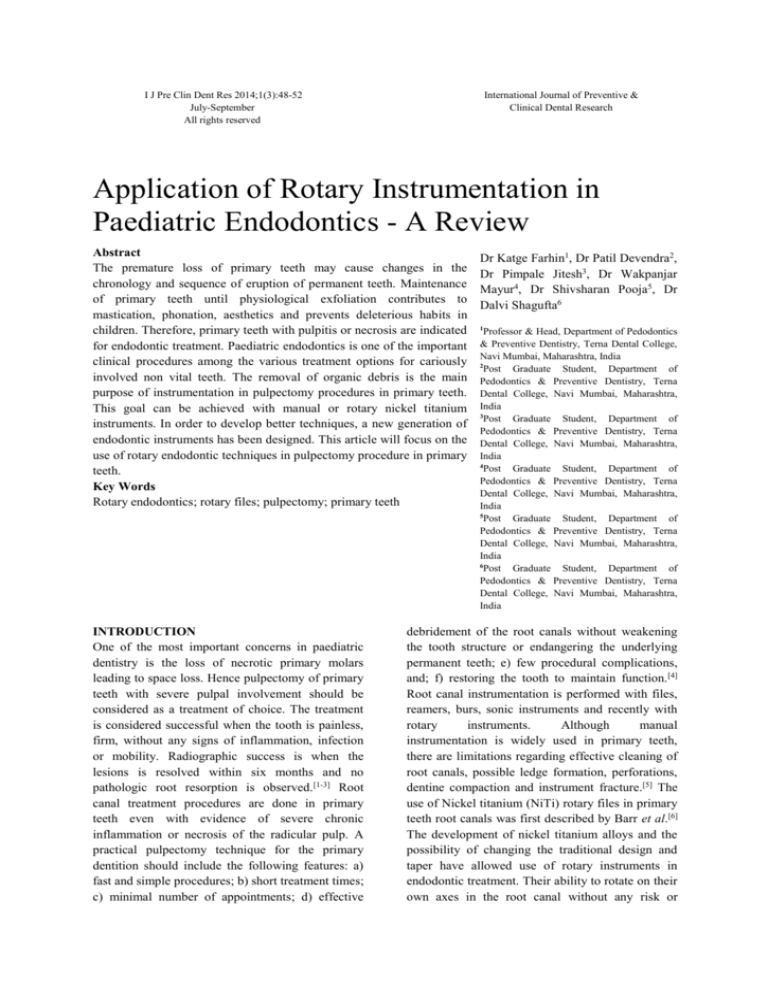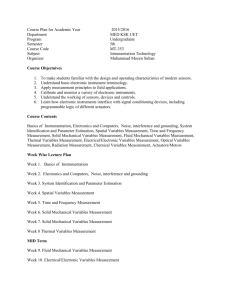
I J Pre Clin Dent Res 2014;1(3):48-52
July-September
All rights reserved
International Journal of Preventive &
Clinical Dental Research
Application of Rotary Instrumentation in
Paediatric Endodontics - A Review
Abstract
The premature loss of primary teeth may cause changes in the
chronology and sequence of eruption of permanent teeth. Maintenance
of primary teeth until physiological exfoliation contributes to
mastication, phonation, aesthetics and prevents deleterious habits in
children. Therefore, primary teeth with pulpitis or necrosis are indicated
for endodontic treatment. Paediatric endodontics is one of the important
clinical procedures among the various treatment options for cariously
involved non vital teeth. The removal of organic debris is the main
purpose of instrumentation in pulpectomy procedures in primary teeth.
This goal can be achieved with manual or rotary nickel titanium
instruments. In order to develop better techniques, a new generation of
endodontic instruments has been designed. This article will focus on the
use of rotary endodontic techniques in pulpectomy procedure in primary
teeth.
Key Words
Rotary endodontics; rotary files; pulpectomy; primary teeth
INTRODUCTION
One of the most important concerns in paediatric
dentistry is the loss of necrotic primary molars
leading to space loss. Hence pulpectomy of primary
teeth with severe pulpal involvement should be
considered as a treatment of choice. The treatment
is considered successful when the tooth is painless,
firm, without any signs of inflammation, infection
or mobility. Radiographic success is when the
lesions is resolved within six months and no
pathologic root resorption is observed.[1-3] Root
canal treatment procedures are done in primary
teeth even with evidence of severe chronic
inflammation or necrosis of the radicular pulp. A
practical pulpectomy technique for the primary
dentition should include the following features: a)
fast and simple procedures; b) short treatment times;
c) minimal number of appointments; d) effective
Dr Katge Farhin1, Dr Patil Devendra2,
Dr Pimpale Jitesh3, Dr Wakpanjar
Mayur4, Dr Shivsharan Pooja5, Dr
Dalvi Shagufta6
1
Professor & Head, Department of Pedodontics
& Preventive Dentistry, Terna Dental College,
Navi Mumbai, Maharashtra, India
2
Post Graduate Student, Department of
Pedodontics & Preventive Dentistry, Terna
Dental College, Navi Mumbai, Maharashtra,
India
3
Post Graduate Student, Department of
Pedodontics & Preventive Dentistry, Terna
Dental College, Navi Mumbai, Maharashtra,
India
4
Post Graduate Student, Department of
Pedodontics & Preventive Dentistry, Terna
Dental College, Navi Mumbai, Maharashtra,
India
5
Post Graduate Student, Department of
Pedodontics & Preventive Dentistry, Terna
Dental College, Navi Mumbai, Maharashtra,
India
6
Post Graduate Student, Department of
Pedodontics & Preventive Dentistry, Terna
Dental College, Navi Mumbai, Maharashtra,
India
debridement of the root canals without weakening
the tooth structure or endangering the underlying
permanent teeth; e) few procedural complications,
and; f) restoring the tooth to maintain function.[4]
Root canal instrumentation is performed with files,
reamers, burs, sonic instruments and recently with
rotary
instruments.
Although
manual
instrumentation is widely used in primary teeth,
there are limitations regarding effective cleaning of
root canals, possible ledge formation, perforations,
dentine compaction and instrument fracture.[5] The
use of Nickel titanium (NiTi) rotary files in primary
teeth root canals was first described by Barr et al.[6]
The development of nickel titanium alloys and the
possibility of changing the traditional design and
taper have allowed use of rotary instruments in
endodontic treatment. Their ability to rotate on their
own axes in the root canal without any risk or
49
Rotary instrumentation in paediatric
Fig. 1: Endodontic system (X smart plus,
Denstply Malliefer, Switzerland)
Farhin K, Devendra P, Jitesh P, Mayur W, Pooja S, Shagufta D
Fig. 2: Endodontic system (Endomate, NSK)
Fig. 3: Endodontic system (X smart plus,
Denstply Malliefer, Switzerland)
damage to the original anatomy is very important.
Among other advantages, the nickel titanium files
do not need to be precurved due to elastic memory,
and the root canal preparation is quicker because
they are activated by an endomotor. The possibility
of root canal deformation is reduced due to its
elastic memory and radial land that maintain the file
in the center of the root canal by wall support.[5,7,8]
In primary teeth, perforations occur more often due
to thin dentinal walls. Apical overextension of the
NiTi can result in an enlarged apical foramen and
causes overfill of obturation paste. Sterile water,
saline or sodium hypochlorite (1% or 2.5%) can be
used to for irrigation of canal. Instrumenting the
canals dry or aggressively can result in broken file
tips, especially in the smaller size files. Frequently
inspect each file for flute unwinding or distortion
and discard immediately. If no flute distortion is
detected, discard the files after use in five primary
teeth. To keep track of file usage, the file shanks
can be notched with a bur at the end of each case. [5]
When compared to the permanent dentition, the
rotary instrumentation is faster in deciduous teeth,
probably due to the smaller root canal length. The
rotary technique also facilitates obturation and
minimizes the extrusion of material. Rotary files
also favour the patient’s cooperation by shortening
treatment time for cleaning canals. However, the
high cost of NiTi rotary systems and need for
training to learn the techniques are disadvantages
Fig. 4: Endodontic system (Endomate, NSK)
of NiTi rotary files (Fig. 1 & Fig. 2).[6,9] Many
authors have reported clinical success in primary
molars with a modified protocol using Profile,
ProTaper (Fig. 3), Mtwo (Fig. 4) , Flexmaster, Light
Speed LSX, Hero 642 and K3 rotary files. The
present article presents a comprehensive, critical
summary of current knowledge and application of
rotary instrumentation techniques in pulpectomy
procedure in primary teeth.
Application of rotary instrumentation techniques
in pulpectomy procedure:
According to Barr et al.,[6] in 2000, Crespo S et
al.,[20] in 2008, the pulpectomy procedure begins
with a standard access and removal of coronal
tissue. Pre-treatment radiograph was taken to
determine the working length. A NiTi file was
chosen that approximates the canal size. It was
inserted into the canal while rotating till the
calculated working length. The canal was cleansed
and shaped with sequentially larger files until the
last file binds. Each time the file was withdrawn, it
was cleaned of pulp tissue and dentinal debris. For
cleaning and shaping of root canals in primary teeth,
ProFile 0.04 instruments was used at slow speed of
150 to 300 rpm. It is not necessary to use a “crown
down” instrumentation technique in primary teeth
since the dentin cuts more easily than in permanent
teeth. This has also been proved by the study done
50
Rotary instrumentation in paediatric
by Silva et al.,[5] in 2004 and Canoglu H et al.,[19] in
2006 in which the root canal was instrumented with
rotary Profile .04 (Dentsply/Maillefer) instruments
up to a 35 size file. Then the files were stepped back
with 40, 45, and 50 size rotary Profiles .04 in root
canals. Ching Kou et al.,[4] in 2006 used Sx file for
instrumentation of canal to about 3 mm beyond the
root canal orifice with a slight buccolingual
brushing motion to remove any remaining overlying
dentin and to improve straight line access. The S2
file was then inserted into the canal while rotating
and taken to the working length as previously
determined. If a point of resistance was
encountered, no attempt was made to go beyond the
resistance point to avoid risk of instrument
separation. Pulp tissue was commonly wrapped
around the S2 file when it was withdrawn. This was
uncommonly found with stainless steel files.
Copious irrigation with 2.5% sodium hypochlorite
and normal saline was used during each file. Lateral
perforation was avoided by using only SX and S2
files during preparation. S1 and F series files were
not used as they said the increased taper and tip size
resulted in excessive apical dentin removal in
primary molars. Since the tooth was already
undergoing physiological root resorption, the
greater taper and F2 file might be a better choice
than S2. Nagaratna PJ et al.,[10] in 2006
instrumented root canal with profile 0.04 taper 29
series rotary instruments starting from size 2 to 7 in
reduction gear hand piece. Files were advanced
slowly towards the apex, which were withdrawn
when working length was reached. Bahrololoomi Z
et al.,[11] in 2007 performed instrumentation with
25-mm-long flexmaster Ni-Ti rotary files (VDW,
Germany) using a modified crown down technique
with 35/0.06, 35/0.04, 30/0.06 and 40/0.02 tapers.
Shaping was completed with a gentle advance and
withdrawal motion. Instruments were removed
when resistance was felt and changed for the next
instrument. Kummer TR et al.,[12] in 2008 prepared
root canal with the Hero 642 system (MicroMega)
and a reducing 50:1 handpiece (MicroMega).
Preparation was performed with 21 mm nickel
titanium instruments with 2% and 4% taper using
the crown down technique. The protocol established
for instrumentation comprised a kit with 3
instruments: 1) Hero 642 taper 0.04, size 30, 2 mm
short of the working length; 2) Hero 642 taper 0.02,
size 35, up to the working length; 3) Hero 642 taper
0.02, size 40, up to the working length. Each Hero
instrument was introduced into the canal with a
Farhin K, Devendra P, Jitesh P, Mayur W, Pooja S, Shagufta D
gentle push and pull motion. Moghaddam KN et
al.,[13] in 2009 instrumented with rotary Flex Master
(VDW) instruments. At first the root canal orifices
were enlarged with the orifice shaper “Introfile”
(VDW) until the root canal middle third was
reached. Crown down preparation was performed
with a 64:1 speed gear reduction handpiece as
follows. At first 25/04 was used until the resistance
was felt followed by 25/02 till the working length.
Azar MR, Mokhtare M,[14] in 2011 and Azar MR et
al.,[9] in 2012 used 21 mm long Mtwo NiTi rotary
files driven with a torque limited rotation with
maximum speed of 280 rpm for preparing root
canals. Four Mtwo instruments (10/0.04, 15/0.05,
20/0.06 and 25/0.06) were used in a crown down
technique till the working length in primary teeth.
According to Pinheiro SL et al.,[15] in 2012, root
canals were prepared using ProTaper using a
handpiece with an electric motor X-Smart
(Dentsply). At a speed of 300 rpm and torque of
3N/cm, S1 and S2 ProTaper files were used for
shaping the primary molar root canals. For F1 and
F2, 2N/cm torque with speed of 300 rpm was used
with an anticurvature filing method for finishing the
canals. Azar MR et al.,[9] in 2012 modified the
sequence of the three ProTaper instruments slightly
to prepare the canals. Root canals were cleaned in a
crown down method with three instruments in the
sequence from S1 in the coronal third of the root
canal, S2 in the middle third, and F1 till the working
length. Pinheiro SL et al.[16] in 2012 used hybrid
technique for instrumentation of canals in primary
molars with the ProTaper system and K-files
(Dentsply Maillefer). Root canals were prepared
initially by manual instrumentation using a size 15
K-file followed by S1 and S2 of the rotary system;
then
again
instrumenting
with
manual
instrumentation with size 15 and 20 K-files
followed by rotary using a system F1. Finally
instrumentation
was
done
with
manual
instrumentation with size 25 K-file and F2 using a
rotary system. Ozen, B, Akgun OM,[17] in 2013 used
Protaper and Hero 642 for instrumentation of the
canals. The protocol followed was using Sx, S1, S2
in a crown down manner with the ProTaper system.
This was followed by F1, F2 and F3 till the working
length. For Hero 642, 2% and 4% taper files were
used in the crown down technique for preparation of
canal. Vieyra JP, Enriquez FJ[18] in 2014
instrumented root canals with rotary Light Speed
LSX instruments (Discus Dental, USA) and
ProTaper file (Maillefer, Ballaigues, Switzerland).
51
Rotary instrumentation in paediatric
The rotary Light Speed LSX instruments were used
in the canal preparation to a size 50 for anteriors
and to size 40 for molars. For Protaper the root
canals were instrumented with SX orifice opener
rotary file for widening the orifice and then with S1
to F2 till the full working length.
Rotary instrumentation, instrumentation time
and cleaning ability in primary teeth
The rotary instrumentation technique was more
effective for root canal instrumentation in primary
molars, presenting shorter treatment time and better
cleaning ability compared to the manual
technique.[3,5,9-18]
Advantages of rotary instrumentation in
primary teeth [5,6]
Tissue and debris are more easily and quickly
removed
The nickel titanium files are flexible, allowing
easy access to all canals
Nickel titanium files do not need to be precurved
Nickel titanium rotary files follow original root
canal anatomy
Less instrumentation time
Prepared canals are funnel shaped, resulting in a
more predictable uniform fill of obturation paste
Disadvantages of rotary instrumentation in
primary teeth [6]
Cost of the endomotor and handpiece
Increased cost of NiTi endodontic files
Cyclic fatigue of endodontic instruments
Endodontic instruments are prone to fracture
Learning the technique
CONCLUSION
The literature on rotary root canal preparation
techniques is limited and there are not many studies
available for use in primary teeth. The comparison
between the various systems is limited and therefore
conclusions are difficult to draw. Rotary
instrumentation can be used in pulpectomy
procedures in primary teeth because of its greater
ease in technique. The decrease in instrumentation
time lessens the chair time which is important factor
while treating children.
REFERENCES
1. McDonald RE, Avery DR. Dentistry for the
child and adolescent. 7th ed. St. Louis: Mosby,
2000. p. 401.
2. Cohen S, Hargreaves KM. Pathways of the
Pulp. 9th Edition. St. Louis: Mosby, 2006. p.
301-11, 842.
3. Moghaddam KN, Mehran M and Zadeh
HF. Root canal cleaning efficacy of rotary and
Farhin K, Devendra P, Jitesh P, Mayur W, Pooja S, Shagufta D
4.
5.
6.
7.
8.
9.
10.
11.
12.
13.
hand files instrumentation in primary molars.
Iran Endod J 2009;4(2):53-7.
Kuo C, Wang Y, Chang H, Huang G, Lin C,
Li U, et al. Application of Ni-Ti rotary files
for pulpectomy in primary molars. J Dent Sci
2006;1(1):10-5.
Silva LA, Leonardo MR, Nelson-Filho P,
Tanomaru JM. Comparison of rotary and
manual instrumentation techniques on cleaning
capacity and instrumentation time in
deciduous molars. J Dent Child 2004;71(1):457.
Barr ES, Kleier DJ, Barr NV. Use of nickeltitanium rotary files for root canal preparation
in primary teeth. Pediatr Dent 2000;22(1):778.
Walia H, Brantley W and Gerstein H. An
Initial Investigation of Bending and Torsional
Properties of Nitinol Root Canal Files. J
Endod 1988;14(7):346-51.
Coleman CL, Svec T, Wang M, Suchina J,
Glickmaan GN. Stainless steel versus nickeltitanium K-files: Analysis of instrumentation
in curved canals. J Endo 1995;21(4):221.
Azar MR, Safi L, Nikaein A. Comparison of
the cleaning capacity of Mtwo and ProTaper
rotary systems and manual instruments in
primary teeth. Dent Res J 2012;9(2)146-51.
Nagaratna PJ, Shashikiran ND, Subbareddy
VV. In vitro comparison of NiTi rotary
instruments and stainless steel hand
instruments in root canal preparations of
primary and permanent molar. J Indian Soc
Pedod Prev Dent 2006;24(4):186-91.
Bahrololoomi Z, Tabrizizadeh M, Salmani L.
In Vitro Comparison of Instrumentation Time
and Cleaning Capacity between Rotary and
Manual Preparation Techniques in Primary
Anterior Teeth. J Dent Tehran Univ Med Sci
2007;4(2):59-62.
Kummer TR, Calvo MC, Cordeiro MM, de
Sousa Vieira R, de Carvalho Rocha MJ. Ex
vivo study of manual and rotary
instrumentation techniques in human primary
teeth. Oral Surg Oral Med Oral Pathol Oral
Radiol Endod 2008;105(4):84-92.
Moghaddam KN, Mehran M and Zadeh HF.
Root canal cleaning efficacy of rotary and
hand files instrumentation in primary molars.
Iran Endod J 2009;4(2):53-7.
14. Azar MR, Mokhtare M. Rotary Mtwo
system versus manual K-file instruments:
52
15.
16.
17.
18.
19.
20.
Rotary instrumentation in paediatric
Efficacy in preparing primary and permanent
molar root canals. Indian J Dent Res
2011;22(2):363.
Pinheiro SL, Neves LS, Pettorossi Imparato
JC, Duarte DA, da Silveira Bueno CE, Cunha
RS. Analysis of the instrumentation time and
cleaning between manual and rotary
techniques in deciduous molars. RSBO
2012;9(3):238-44.
Pinheiro SL, Araujo G, Bincelli I, Cunha R,
Bueno C. Evaluation of cleaning capacity and
instrumentation time of manual, hybrid and
rotary instrumentation techniques in primary
molars. Int Endod J 2012;45(4):379–85.
Ozen, B, Akgun, OM. A Comparison of Ni-Ti
Rotary and Hand Files Instrumentation in
Primary Molars. J Int Dent Med Res
2013;6(1):6-8.
Vieyra JP, Enriquez FJ. Instrumentation Time
Efficiency
of
Rotary
and
Hand
Instrumentation Performed on Vital and
Necrotic
Human
Primary Teeth:
A
Randomized
Clinical
Trial.
Dentistry
2014;4:214.
Canoglu H, Tekcicek MU, Cehreli ZC.
Comparison of conventional, rotary, and
ultrasonic preparation, different final irrigation
regimens, and 2 sealers in primary molar root
canal therapy. Pediatr Dent 2006;28(6):51823.
Crespo S, Cortes O, Garcia C, Perez L.
Comparison between rotary and manual
instrumentation in primary teeth. J Clin Pediatr
Dent 2008;32(4):295-8.
Farhin K, Devendra P, Jitesh P, Mayur W, Pooja S, Shagufta D





